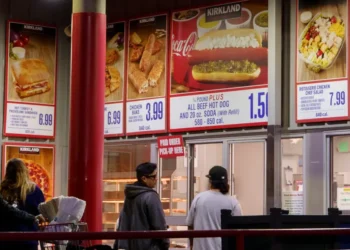Getty Images; Reuters
The CEOs of the two largest ride-hailing platforms in the US see significant potential in attracting more customers and generating additional revenue with autonomous vehicles.
How and when they arrive there may differ.
During their respective Q3 earnings calls last week, Uber CEO Dara Khosrowshahi and Lyft CEO David Risher fielded multiple questions about their robotaxi expansion plans.
Both companies have secured partnerships with Waymo and others to deploy autonomous vehicles for their fleets in the near future. Still, the partnership structure won't be the same in every market, leaving room for Uber and Lyft to carve out ways to earn money through those relationships.
Meanwhile, the CEOs of both companies say that so far, they're seeing the rideshare market grow in areas where autonomous vehicles are deployed.
"The biggest scale operations that we've got are with Waymo in Austin and Atlanta," Khosrowshahi said during Uber's earnings call. "And what we are seeing is that those markets are growing faster than other US markets."
Risher expressed a similar sentiment, saying, "We like the economics of AVs a lot," during Lyft's earnings call on Wednesday.
Here's what they've recently said about their visions for robotaxis.
A hybrid future
It may not be shocking that the chief executives of companies whose businesses rely on a large network of human drivers would say that the future of ride-hailing will be hybrid for some time.
Risher, the Lyft CEO, provided a little more insight into the why.
"It's really, really hard to satisfy demand just with AVs anytime in the near future," he said. "There's just not enough supply in the world."
Risher added that human drivers also provide their own cars — one less asset Lyft has to provide.
Meanwhile, Uber is addressing the robotaxi supply issue through its OEM partnerships. The company has partnered with Stellantis to bring at least 5,000 robotaxis to its global fleet. It has also partnered with Lucid and Nuro to deploy 20,000 robotaxis over the next six years.
Still, that would pale in comparison to the number of vehicles potentially owned among the 9.4 million drivers and couriers globally on the Uber platform.
An Uber spokesperson did not respond to a request for comment.
Robotaxi markets are seeing more riders
Publicly available robotaxis are limited to a handful of cities, but in areas where active AVs are present, both CEOs reported that overall demand is growing faster than in areas without self-driving taxis.
"In markets where AVs operate, rideshare is growing faster than — and I'm talking about comparable apples-to-apples markets — than markets where AVs are not operating," Risher said.
There are a lot of reasons that demand could be growing where robotaxis are active.
Robotaxis are still a novel technology for most people. In San Francisco, Waymos have become a tourist attraction.
There's also potential for complementary effects, such as human drivers taking care of longer trips. In addition, they could be making other vehicles more available since robotaxis operate 24/7.
"Early results indicate that AV rides expand total market demand and, ultimately, help reduce reliance on personal vehicle rides across a massively under-penetrated transportation market," CJ Macklin, a Lyft spokesperson, told Business Insider.
Profits yet to come
Both CEOs agree that autonomous vehicles are a massive investment.
Khosrowshahi highlighted the need to build a fleet of robotaxis, which he said will be funded in part through the margins seen from Uber's existing premium services.
In addition, Uber's partnership with Nvidia, in which Uber will provide driving data to train the chipmaker's autonomous AI models, envisions a future where any OEM car will be robotaxi-ready. Khosrowshahi said this will be beneficial to Uber if owners decide to contribute their cars to the platform.
Risher pointed to the operational investments required to keep robotaxis available for customers. For Lyft's partnership with Waymo in Nashville, customers will be able to hail a robotaxi on both Waymo's proprietary app and the Lyft app.
However, Lyft will oversee the maintenance of all Waymo robotaxis through its subsidiary, Flexdrive. The company invested in a depot that could cost between $10 and $15 million for that operation, Lyft's Chief Financial Officer, Erin Brewer, said during the latest earnings call.
Risher said that the partnership structure will allow robotaxis to be "accretive" from the start.
"With Waymo's utilization of services provided by Flexdrive and the anticipated increase in overall ride volume on both networks, we expect the unit economics will be accretive," Macklin, the Lyft spokesperson, said.
Overall profitability, however, may take some time.
"AV is not profitable," Khosrowshahi said. "And any new product that we introduce into the marketplace starts off in a position where we're losing money and we're unprofitable."
In other words, the robotaxis are here, but the money's yet to come.
Read the original article on Business Insider
The post Uber and Lyft see more demand with robotaxis. Here’s what their CEOs say about a driverless future. appeared first on Business Insider.




